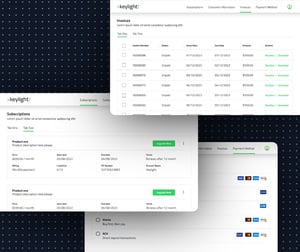The Anatomy of Subscription Businesses | Part five
![]() n the past we have written about the shift from one-off sales to subscription-based business models. While we may often associate subscriptions with digital services, manufacturing is at the forefront of that shift, with much to gain, but only if companies can change their way of thinking.
n the past we have written about the shift from one-off sales to subscription-based business models. While we may often associate subscriptions with digital services, manufacturing is at the forefront of that shift, with much to gain, but only if companies can change their way of thinking.
The reason that subscription models have so much to offer manufacturing organizations, is that they provide a more sustainable revenue stream and cash flow solution to traditional ways of working. Manufacturing, especially large-scale manufacturing like heavy customizable machinery produced at volume but purchased as large one-time transactions, requires a significant upfront investment. A subscription model allows organizations to move to a monthly revenue stream instead.
We have previously discussed how subscription models can support a range of businesses and industries, ranging from health and fitness to Energy as a Service. In this article, we explore how manufacturing organizations can shift to a subscription-based model, the barriers to that transformation, and how to overcome them.
Industry 4.0 and its impact on manufacturing
Industry 4.0, or the fourth industrial revolution, and the Internet of Things (IoT), are all about using interconnectivity, automation, machine learning, and real-time data. In manufacturing, this is transforming the way companies manufacture, improve and distribute their products, driving advances in quality, reliability, and agility.
Traditionally, in heavy manufacturing (e.g. shipbuilding, machine tool building, locomotive manufacturing, mining, and steel production), a substantial portion of revenue and profit comes from one-time transactions of highly customizable products. We have already mentioned the high level of risk and cash flow difficulty that comes from needing a vast upfront investment followed by a hefty one-off purchase.
The knock-on effect is that businesses lose touch with their customers for the lifecycle of the product and therefore miss the opportunity to market add-ons, replacement parts, and repairs, as well as open themselves up to a re-order.
Integrating new technologies and digital, customer-centric strategies has led many manufacturers to subscription service models. As a result, they shift from a model based on ownership of products to one based on access to products, offering manufacturers the opportunity to scale businesses more sustainably.
According to the Business Innovation Observatory of the European Commission: “70% of machine manufacturers consider services to be a key competitive differentiator. Machine manufacturers who shifted towards service-based business models have seen 5% to 10% annual business growth, with services generating 50% of their revenues.”
Employing a subscription-based model not only enables a service-based approach but also allows businesses to maximize the opportunity and improve business outcomes by:
- Employing advanced data usage to advance the use of analytics and better understand customers
- Knowing what the customer wants, and when, can help create a sense of loyalty
- This in turn helps manufacturers predict their costs and revenues in advance
The scope of subscriptions for manufacturing industries
There are three main areas of transformation for manufacturers moving to a subscription-based service model, all of which offer direct business benefits:
Moving from a static to a dynamic business model
When we think of Industry 4.0, we tend to think of the transformative powers of the technology associated with it, but the most transformative opportunities come from business model innovation. This is about a change in the way we think and operate - technology is an enabler for that mindset.
Industry 4.0 is about creating an ecosystem of interconnecting businesses and technologies. Put simply, it’s a circular approach rather than a linear one. Historically, manufacturing businesses used a static business model:
- A product is manufactured
- The products are sold and marketed through a variety of platforms and distribution channels
- The goal is to sell the maximum number of units to the end-user
A dynamic business model maintains an ongoing circle of communication and connectivity that revolves around the customer:
- The customer subscribes
- They maintain ongoing connectivity through a variety of platforms and channels
- The manufacturer continues to learn about customer wants and needs
- The manufacturer responds to the evolving the customer relationship in order to maintain the subscription
As a result, the business has more monetization opportunities by improving the customer experience. Those monetization opportunities are not just academic either. For example, Damien Dujacquier, Co-Managing Partner at Roland Berger, noted that:
“In Germany, the heartland of mechanical and plant engineering, 80% of revenue is generated by the sale of new equipment and 20% by services – but that 20% accounts for 60% of profits.”
Transforming to a dynamic business model is not without challenges, however. It has implications for the way everything, including product solution/market fit, revenue, cash flow, and the balance sheet is thought about and handled.
Expanding reach and adapting to real-time needs
Where traditional models might have operated on the logic of maximizing economies of scale, a subscription revenue model is about using greater connectivity to understand customers and address their needs in real-time through constantly up-to-date solutions. That connectivity is enabled by cloud technologies, the Internet of Things, platform offerings, etc. The benefits of that constant connectivity and real-time response, include:
- The compilation of customer experience to feed insights to continuously create new solutions
- Continual customer communication to meet individual needs
- Businesses maintain ownership of that relationship instead of losing it to a competitor
Central to the customer experience is a flexible approach - an important area of consideration for manufacturing companies hoping to adapt to Industry 4.0 and remain competitive in the market. One of the appeals of subscription models from a customer perspective is the ability to access usage-based billing that allows for the personalization and scalability of service.
It’s a transformation that has already played out in other industries like software or media, and those who don’t embrace it in manufacturing are likely to find themselves facing significant new competition and a loss of market share.
Customer-centric innovations for faster growth revenue
The gold standard of subscription-based business models in any industry is a focus on the customer, but for all businesses, how that translates to revenue is essential.
The research found that subscription businesses have grown nearly six times faster than the S&P 500 over the last nine years, and that includes manufacturers embracing digital subscription services, who saw significant revenue growth compared to a revenue decline for their S&P counterparts.
As a basic point of principle, subscription models hinge on maintaining relationships rather than constantly finding new ones.
Maintaining existing relationships is both an easier and more cost-effective option. However, by continuously accumulating relationships businesses also establish ongoing, more predictable revenue streams, whilst also driving down the cost of acquisition by focusing on the lifetime value of the customer. The less tangible advantages of brand advocacy and recommendations brought about by engaged and satisfied customers are also significant.
The maintenance of that relationship and compounding revenue growth hinges on customer-centric innovations, which are fed and enabled by having a direct relationship with end-users and an in-depth understanding of usage, misusage, customer pains, and customer demands. All of this is enabled through purpose-built systems and processes for subscription models.
The risks of transforming to a subscription-based business model
While Industry 4.0 heralds exciting opportunities in manufacturing, transforming to a subscription-based business model is not without its challenges. As with all things, however, the risk involved hinges on how the process is managed and implemented.
Business disruption
Undergoing a significant business transformation can be understandably disruptive. Getting it wrong can be extremely destructive, but the benefits of getting it right can present a once-in-a-lifetime opportunity - as you can see from the aforementioned revenue growth statistics. It’s therefore important for businesses to have the right support in place to ease the way - namely, the right systems and processes.
Inadequate CPQ and product catalog
Where customized service subscriptions and complex industrial equipment is concerned, it can be a real challenge for organizations to create processes that configure pricing and quoting accurately. The risks come from not using purpose-built systems, which leads to:
- Disjointed and inefficient processes
- Duplicate data
- A lack of support for usage-based pricing and individual requirements
- A poor customer experience
The result can be a slow sales cycle and high sales costs, which somewhat defeats the objective.
Systems and capabilities
It is very difficult to find systems that can handle everything that a successful subscription model needs. Since data is the backbone of subscriptions, predictive analytics really helps, requiring robust software architecture for managing big data and analytics.
The benefits of getting that right include untold opportunities and insights for manufacturers. However, the risk of inefficient usage and processing results in disruption for both the organization and the customer. It also leads to an inability to act on the customer’s wants and needs effectively and accurately, which has a knock-on effect on maintaining the customer relationship and will ultimately damage revenue.
Manufacturing business solutions for Industry 4.0
The solution for manufacturing businesses looking to transform to a subscription-based service model is in having the systems and processes in place to ensure a smooth transition followed by seamless customer experiences and maintenance of those relationships. At keylight we offer one system that can configure all processes seamlessly in a single platform:
One unified subscription system
Our one unified subscription system enables the seamless orchestration of all processes, including:
- Proactive commerce and subscription lifecycle management. This enables dynamic relationships through recurring transactions.
- A powerful product catalog, including inbuilt, configure price, and quote capability allowing agile pricing and packaging that power new monetization models.
- Refined billing logic for the digital rating and invoicing to support billing, as well as flexibility and coverage for the collection process.
- Audit-ready, automated financial operations to respect new revenue recognition imperatives.
Predictive analytics
Predictive analytics is a game-changer for manufacturing businesses entering the service space, opening up opportunities by providing:
- Access to real-time key metrics.
- Analysis of customer behavioral trends in addition to the regular annual recurring revenue, churn rate, and a growth index. This gives you insights into customer behavior and allows you to predict the lifetime value of the customer, which is essential for businesses to track progress.
Ultimately, subscriptions aren’t a short-term strategy. They’re a long-term investment to help manufacturers scale operations globally. However, done well, the opportunities are endless.

Upgrade from traditional engines
to a robust subscription system
Start now with >keylight/






